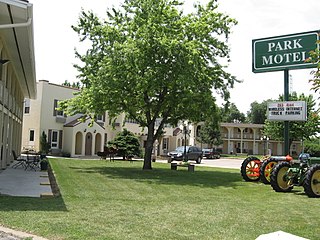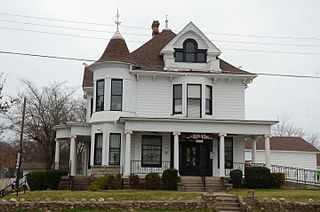
A motel, also known as a motor hotel, motor inn or motor lodge, is a hotel designed for motorists, usually having each room entered directly from the parking area for motor vehicles rather than through a central lobby. Entering dictionaries after World War II, the word motel, coined as a portmanteau of "motor hotel", originates from the Milestone Mo-Tel of San Luis Obispo, California, which was built in 1925. The term referred to a type of hotel consisting of a single building of connected rooms whose doors faced a parking lot and in some circumstances, a common area or a series of small cabins with common parking. Motels are often individually owned, though motel chains do exist.

Hot Springs is a resort city in the state of Arkansas and the county seat of Garland County. The city is located in the Ouachita Mountains among the U.S. Interior Highlands, and is set among several natural hot springs for which the city is named. As of the 2020 United States Census, the city had a population of 37,930.

This is a list of properties and historic districts in Arkansas that are listed on the National Register of Historic Places. There are more than 2,600 listings in the state, including at least 8 listings in each of Arkansas's 75 counties.

U.S. Route 66 in the state of Texas extended across the Texas Panhandle from its designation in 1926 to its decommissioning in 1985.

Hillcrest Historic District is an historic neighborhood in Little Rock, Arkansas that was listed on the National Register of Historic Places on December 18, 1990. It is often referred to as Hillcrest by the people who live there, although the district's boundaries actually encompass several neighborhood additions that were once part of the incorporated town of Pulaski Heights. The town of Pulaski Heights was annexed to the city of Little Rock in 1916. The Hillcrest Residents Association uses the tagline "Heart of Little Rock" because the area is located almost directly in the center of the city and was the first street car suburb in Little Rock and among the first of neighborhoods in Arkansas.

Ward Wellington Ward (1875–1932) was an American architect who worked mostly in Syracuse, New York. He designed more than 250 buildings, of which more than 120 were built and survive. He was influenced by, and contributed to, the Arts and Crafts movement in architecture. Ward's work is in varying styles, but the houses most typically include crafts-like details such as decorative cutouts in shutters. His designs almost always include garages, gateways, and other small structures like gazebos.

The Virginia Park Historic District is located on the north side of New Center, an area in Detroit, Michigan, along both sides of Virginia Park Street from Woodward Avenue to the John C. Lodge Freeway access road. The district was listed on the National Register of Historic Places in 1982.

The Park Motel is a historic building located in Denison, Iowa, United States. It is an example of a well-preserved highway motel during the early age of motoring. It appears this is also an early example of a motel in Iowa and may be one of the earliest in the Midwest.

U.S. Route 64 is a U.S. highway running from Teec Nos Pos, Arizona east to Nags Head, North Carolina. In the U.S. state of Arkansas, the route runs 246.35 miles (396.46 km) from the Oklahoma border in Fort Smith east to the Tennessee border in Memphis. The route passes through several cities and towns, including Fort Smith, Clarksville, Russellville, Conway, Searcy, and West Memphis. US 64 runs parallel to Interstate 40 until Conway, when I-40 takes a more southerly route.

The Arizona Rancho, also known as the Higgins House, Brunswick Hotel and Arizona Hotel, is a former hotel in Holbrook, Arizona, United States. It was originally built between 1881 and 1883 as a residence, the expanded as a boarding house, a hotel, and finally as a motel. The original structure is thought to be the oldest extant structure in Holbrook.

The Beech Hill Summer Home District encompasses a collection of six early 20th century summer houses in Harrisville, New Hampshire, built on a ridge overlooking Dublin Pond with views of nearby Mount Monadnock. The properties, a number of which were built for members of the Thayer family, lie on Mason Road, just north of the town line with Dublin. The most significant property of the six is the 140-acre (57 ha) Skyfield estate, whose large Georgian Revival mansion was designed by Lois Lilley Howe and built in 1916. The district is also notable as containing archaeological remnants of 18th century farmsteads, for which reason its properties are also listed in the Harrisville Rural District. The district was listed on the National Register of Historic Places in 1988.

The Web Long House and Motel is a historic former motel complex on the north side of United States Route 63, just east of Springwood Road, on the outskirts of Hardy, Arkansas. The complex includes three buildings: a single-story stone house, which also served as the office for the motel, a duplex located just to its east, also built of flagstone, and a four-unit stone motel building facing south. The complex was built in 1943 by Web Long, president of the Hardy Development Council, as a home for his family and a business serving travelers. It is one of the earliest known examples of motel architecture in Sharp County.

The Bear Creek Motel is a historic motel on United States Route 65 in Bear Creek Springs, Arkansas. It is a single T-shaped stone and concrete building, built in 1936 to replace a wood-framed tourist accommodation that had burned down. The building has a distinctive wave-shaped concrete roof, intended to lure travelers off the road, and houses five guest rooms and an office. The wave shape is continued in the guest rooms, which have barrel-vaulted ceilings, and are also finished in concrete and stone veneer.

The Cottage Courts Historic District encompasses a historic travelers' accommodation at 609 Park Avenue in Hot Springs, Arkansas. Built about 1950, it was one of the first motel-type tourist accommodations to be built in the city. Unlike earlier tourist courts, which typically had idiosyncratic vernacular architecture, Cottage Courts consists of two ranch-style single-story buildings, one of which houses twelve guest rooms, and the other three plus the operator's apartment and office.

The Martone House is a historic house at 705 Malvern Avenue in Hot Springs, Arkansas. It is a 2+1⁄2-story wood-frame structure, with a hip roof, clapboard siding, and a stone foundation. It has Queen Anne Victorian styling, with a gabled projecting window bay, rounded turret projecting at one corner, and a wraparound porch. It was built in 1907 for Thomas and Nina (Cascoldt) Doherty, and is notable as one of Hot Springs' first motel properties, as it was where the Dohertys not only let rooms in the house, but also built cabins to the rear of the property to house more visitors.

The Perry Plaza Court Historic District encompasses a historic tourist accommodation at 1007 Park Avenue in Hot Springs, Arkansas. It consists of a long two-story brick building in the International style, along with a small office building and swimming pool. It houses 19 single-bedroom units, which are now rented as apartments. Built in 1947–48, it is a fine example of the International Style. The unit interiors retain a number of period features, including tile and plumbing fixtures.

The Walker Homestead Historic District encompasses a collection of related agricultural and homesteading properties in rural White County, Arkansas. Located on Gum Spring Road about 1 mile (1.6 km) east of Arkansas Highway 267 southwest of Searcy, the district includes two farmstead houses, a barn, tenant housing, cotton gin, and other features. The oldest portion of the oldest house is a single pen log structure built about 1850 by William Walker, one of the area's early settlers, while the other house is a c. 1900 vernacular Greek Revival structure built by Billy Walker, Sr. The district encapsulates a typical evolutionary history of rural properties in the region, and was listed on the National Register of Historic Places in 1992.



















